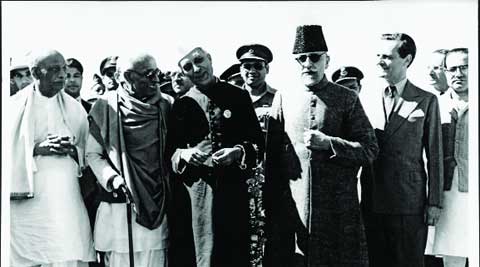Sanjay
Sharma
The Indian Express, 8 February 2014

In the words of the
historian Mushirul Hasan, this book employs an “unconventional form of
storytelling, which seeks to provide the thrill and opportunity of being a
historian and an explorer” to each reader. Through a motley selection of
archival documents like photographs, personal letters, official orders and
speeches (some in Urdu) and colonial records (several classified as
“confidential” and “secret”), the book tries to throw light on some
lesser-known aspects of the life and times of Maulana Abul Kalam Azad, India’s
first education minister.
The dominant image of
Azad has been that of a secular nationalist Muslim — the sherwani, beard and
the topi doing their bit. By all accounts, he was not a secular nationalist to
begin with. He could not be, as the description carried little meaning till the
second decade of the 20th century. Indeed, one can plot the evolution of this
uniquely Indian identity by closely following Azad’s personal and political
journey from his birth in Mecca in 1888 to his final resting place in Urdu Park
in front of the Jama Masjid, Delhi, in 1958.
Like many illustrious
contemporaries, Azad’s public life began in print journalism, where his Islamic
education and learning acquired an anti-imperialist edge. He came in direct
conflict with the colonial regime, especially with his eloquent writings in the
Urdu weekly Al-Hilal, which he started in 1912. Fascinating Home and
Intelligence department documents presented in this volume clearly bring this
out, with one in 1916 describing him as “an extremely able and dangerous man
with very pronounced Pan-Islamist views.”
Predictably, Azad was
drawn to the Khilafat movement, which could have limited him to Muslim issues.
But the Non-Cooperation Movement and Gandhi’s Congress took him to a pan-Indian
path instead of a pan-Islamic one. The scholar-preacher was transformed by the
tide of mass movements. The transformation was not lost on Gandhi, who wrote
about him in Young India on February 23, 1922: “What a change between 1919 and
1922 — nervous fear of sentences and all kinds of defences in 1919, utter
disregard of sentences and no defence in 1922”. A year later, he was elected
Congress President at the age of 35 and as Hasan writes, “he was looked upon, in
spite of his youthful years, as one of the elders of the Congress”.
The
post-Non-Cooperation years of the 1920s saw a resurgence of communal clashes
and Azad was invariably drawn to the question of Hindu-Muslim relations.
However, he did not approach the burning issue exclusively with the clinical
tools of western modernity. Instead, he revisited Islam and found ideas and
inspiration for a theology of “multi-religious cooperation” and the
“transcendental oneness of all faiths”. He went on to situate himself in the
rich composite legacy of Islam that he fervently advocated in the 1940s, which
were laced with separatist Islamist forces. In this, he received the trust of
the Congress and led the party for an interrupted spell from 1939-46. Azad’s
commitment to the idea of an inclusive India grew firmer and his rejection of
the two-nation theory invited charges of him being a leader of token symbolic
value and just a titular head during the negotiations with the Cripps and
Cabinet Missions.
We do not know enough
about how Azad dealt with this because despite spending 10 years in jail, he
did not write as much as some of his prolific contemporaries. Nehru, in fact,
even lamented Azad’s limited written output while acknowledging his learning
and wisdom. Hasan makes an interesting observation: Nehru and Azad were unlike
in many ways and despite coming from diverse backgrounds came to share each
other’s “exuberant inclusiveness”. Azad even succeeded in rubbing off most of
Nehru’s “rough edges”, though he was considered to be quite polished. That is a
lesson for contemporary Indian political culture.
Azad spent the last
10 years of his life as the first education minister of the young republic.
Post-1947, he immersed himself in the task of nation building by pioneering new
institutions like the Indian Council for Cultural Relations, the University
Grants Commission and the Sahitya Akademi.
Some documents here
are gems, sure to delight those interested in the formative years of free
India. For instance, there is a note dated July 11, 1950, regarding the singing
of the national anthem in schools and colleges, and another written on 22
April, 1953, to C Rajagopalachari, emphasising that the Constitution and
Islamic law should uphold the equality of daughters in succession, in the
absence of sons. However, several of these crucial documents are in Urdu.
Translations would have helped.
This book is much
more than what its title suggests. Azad’s life, letters and career give us
further insight into the texture of colonial state power, the arguments its
functionaries manufactured to ban Azad’s early “seditious” writings and to deny
him a passport at one stage. Azad’s own persona needs to be rescued from the
burden of the clichéd meanings of “pluralism” and “secular nationalism”. He was
more than that: someone who richly contributed to the evolution of a rooted
Indian liberal tradition and dared to face the dilemmas of given traditions and
modernity.
(Sanjay Sharma teaches at Ambedkar University, Delhi)


कोई टिप्पणी नहीं:
एक टिप्पणी भेजें